Since I started this blog, I’ve received many readers’ questions about stir fry equipment. For example, should I consider purchasing a wok? Which is the best wok pan to buy? What is the best stir fry pan to choose when cooking with an electric stove? What’s the best setup to cook authentic Chinese stir fry?
Throughout this post I hope to answer all the above questions to clear up any stir fry doubts.
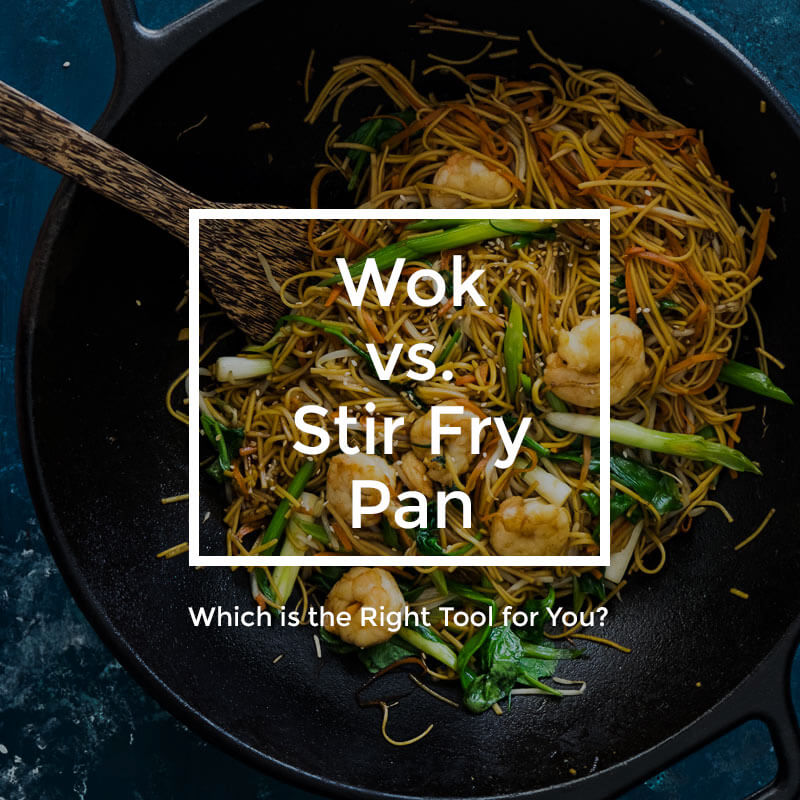
To cover most scenarios, I divided setting up a stir fry station into 3 major categories.
- The easiest setup for most home kitchen and beginners.
- The authentic setup that mimics a Chinese restaurant.
- A setup for serious cooks who do not have the equipment of a commercial kitchen.
Before jumping into the discussion of which wok to buy, let’s firstly look at how to properly set up a wok station and why a wok might not actually be the perfect tool for you.
Commercial Kitchen vs. Home Kitchen
Chinese restaurants use high power gas stoves that generate much hotter flames than a home kitchen. Different from the household gas range, a restaurant stove sits inside of a pit to hold a round bottom wok. When you turn on the heat, the flame can cover at least two thirds, sometimes eighty percent, of the wok. The wok will heat up in a few seconds on the flames and cool down immediately once the wok is removed from the stove. Watch the video below to see the Chinese restaurant setup.
So what’s the output difference between a powerful gas burner like this versus an average gas burner in the home kitchen?
The output of a commercial gas burner can be anywhere between 50,000 BTU to 160,000 BTU. A home kitchen gas burner is about 12,000 BTU or less. An electric stove is less powerful and takes a lot longer to heat up.
Home cooks rarely have a luxury setup like a commercial kitchen. So most of the Chinese cookbooks recommend:
- Carbon steel wok + wok ring + home kitchen gas stove => The wok will be far away from the flame, which makes a less powerful gas burner even weaker.
- Carbon steel flat bottom wok + electric stove / home kitchen gas stove => Only a small bottom area is in contact with a small heat source.
In either scenario, you cannot heat up your wok as thoroughly and fast as in a restaurant.
That’s why I’ve been recommending using a flat stir fry pan in many of my stir fry recipes. When you’re using a flat skillet, the pan is in contact with a larger heat source, and the whole bottom of the pan will heat up relatively fast and evenly. This directly translates to shorter cooking time and better tasting food.
Does cooking with a wok make a difference?
The answer is yes and no.
For dishes using a lot of sauce, for example American Chinese takeout dishes such as Orange Chicken or Kung Pao Shrimp, wok cooking only makes a small difference. For these dishes, as long as you make a nice and flavorful stir fry sauce, the outcome will be as good as, or even better than the ones you order from a takeout restaurant.
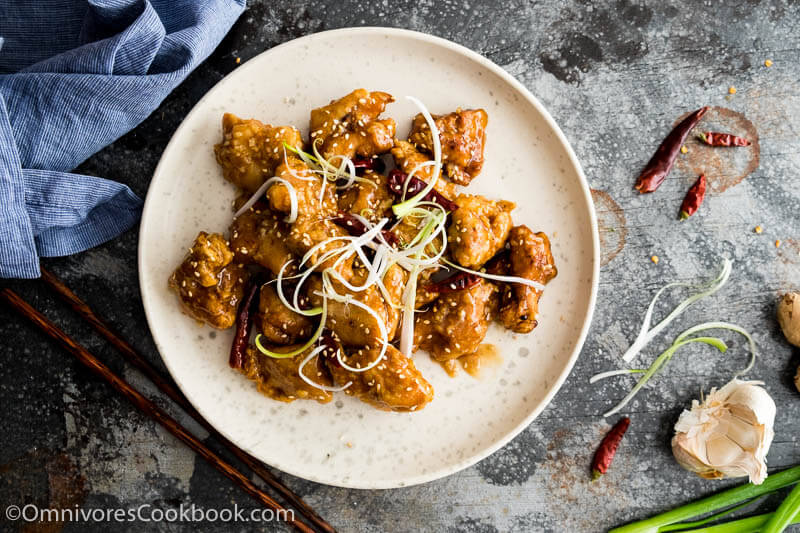
Unlike the Cantonese-style food you see in most overseas Chinese restaurants, there are many other ways to cook stir fry without a thick glossy sauce. For stir fries with little sauce (or “dry stir fry”), which is actually the case for many authentic Chinese dishes, wok cooking has more advantages.
These are the type of dishes that emphasize seasonal produce and spices and aromatics, such as broccoli cooked in a few spoonfuls of chicken stock and garlic, cabbage cooked in chili pepper infused oil, or green beans cooked with minced pork and splash of soy sauce. These dishes require higher heat and faster cooking. The fresh herbs and minimal seasonings have a synergistic effect with the wok air, which impart a heavenly smokiness and deep umami flavor to the dish. When you’re making these dishes with a flat skillet, they will still turn out very tasty, but their flavor risks falling flat compared to the ones cooked in a wok.
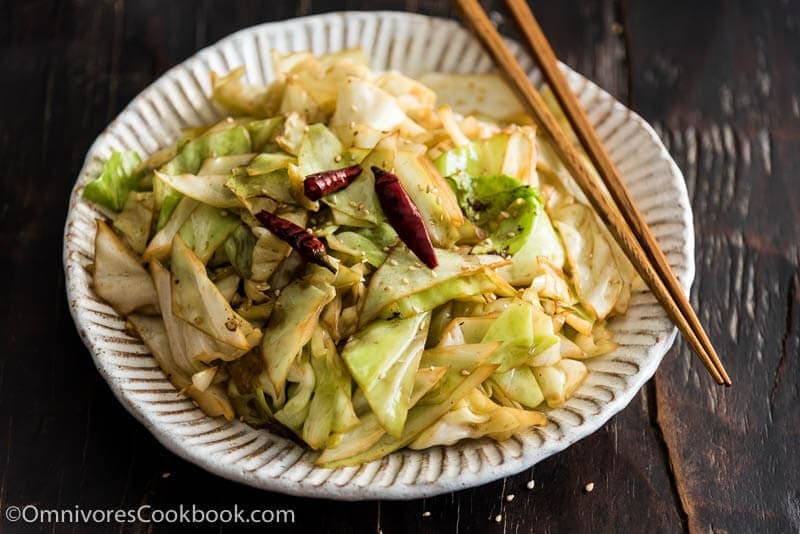
Wok vs. Stir Fry Pan – Three best ways to set up your stir fry station
Having lived in China and the US, I’ve cooked in many home and professional kitchens with different setups. I’ve used various utensils to conduct experiments and to find out the perfect combinations to cook stir fry at home.
Here I designed 3 kitchen setups for:
- The majority of home cooks and beginners.
- Hardcore Chinese cooking fans who have an outdoor cooking space.
- Serious cooks who want to cook better food but do not own an outdoor cooking space.
Let’s look at them one by one.
1. The easiest setup
This setup works for most home cooks.
Nonstick skillet + gas / electric stove
Pros:
- For beginners, it’s much easier to learn and master
- You can cook with an electric stove
- The pan requires less oil for cooking
- The food won’t stick to the pan easily
- The pan is easy to clean up
- The pan does not require extra care
Cons:
- You cannot heat the pan up very hot, because high heat can destroy the nonstick coating
- Ingredients may spill onto the counter since the pan is shallow
- Certain dishes might not turn out as great as the ones cooked in a wok
Overall, a nonstick skillet is the easiest pan to start with. It heats up well even on an electric stove top and requires less oil. When it comes to fried rice and fried noodles, or any ingredients with a lot of starch (such as marinated meat), your pan won’t become a big mess that requires 30 minutes of scrubbing.
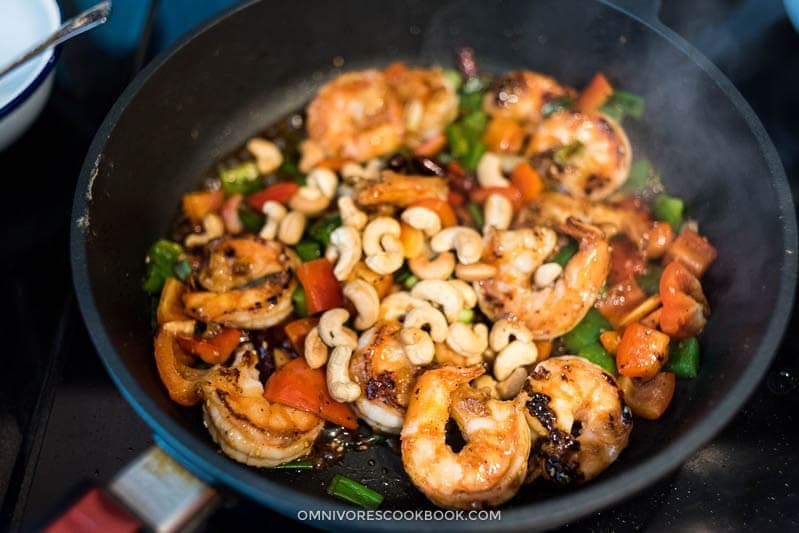
Recommended nonstick pans
Calphalon Nonstick 12-inch Deep Fry Pan – A large, deep skillet at an affordable price. Its bottom sits on the largest element of your electric stove, and it’s tall enough for the stir frying movement. It allows you to heat up the pan to 200 C (400 F).
Woll Diamond Lite 11-Inch Sauté Pan or Woll Titanium 11-Inch Sauté Pan – If you have a bigger budget, I highly recommend this brand. I own the latter pan and it’s one of my favorites for stir frying or pan frying. It’s heavier than most nonstick pans, so it holds heat very well. It is PFOA-free, and its super hard coating lasts longer and also allows you to cook at a higher temperature – 260 C (500 F).
[one_half padding=”0 0 0 2px”]
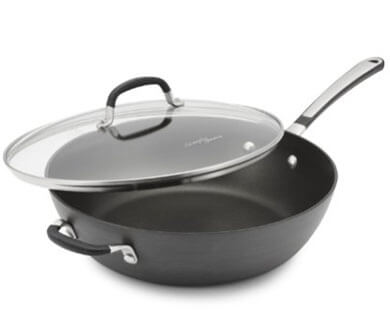
[/one_half]
[one_half_last padding=”0 0 0 2px”]
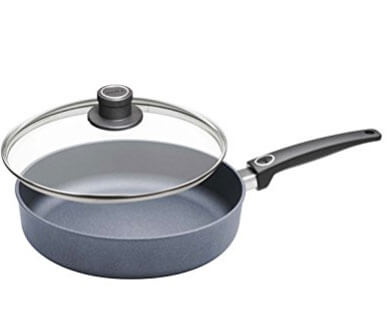
[/one_half_last]
Tip: Toss noodles without spilling ingredients everywhere – use a pair of tongs instead of a spatula.
Note:
None of your nonstick pans will last forever. If you use the pan heavily, a cheap pan usually lasts about 1 year before the coating starts to wear off, and a high quality pan lasts 2 to 4 years.
Never wash the pan right after cooking (when it’s super hot). Never use the abrasive side of the dish washing sponge. Use hot water, mild detergent, and a sponge to rinse it when it cools down a bit. Proper cleaning will extend the lifespan of your pan.
2. The authentic setup
This setup works for serious cooks who own a powerful gas range or have an outdoor cooking space.
Round-bottom carbon steel wok + wok ring + high output gas range
Pros:
- It’s much easier to stir and toss the food. You can do pan tossing if using a smaller wok with one handle
- It is so much easier to control the heat when using a gas stove, which is crucial for stir frying
- You can heat the pan up really hot, so it shortens the cooking time and the food will taste better
- The wok will last forever if you take good care of it
Cons:
- Deeper learning curve – it takes more time to practice before you get used to it
- A wok requires more care (proper seasoning, wash, and dry)
- It generates a lot of smoke during cooking. Your room will smell like a restaurant even if you have a good ventilation fan!
If you’re fortunate enough to own a powerful gas stove, this might be your best option to make Chinese stir fry the authentic way.
The biggest merit of using a gas stove is that you can bump up the heat and turn it down in a second to control it, which is crucial for Chinese stir fry. Sometimes cooking only lasts for 3 to 4 minutes, but you might need to adjust the heat a few times during this short period, so the pan is hot without burning the ingredients.
I would only recommend this setup if you own a powerful indoor gas stove with a efficient ventilation system, or an outdoor cooking space.

Recommended wok
14″ Japanese Style Steel Wok or 16” Carbon Steel Hand Hammered Wok
The best way to set up your wok station is to use a jet burner (62,000 to 160,000 BTU) with a stand that can hold the wok, or a outdoor stove with a round pit (54,000 BTU). You should able to find the burner and the stand in large Asian markets, or the outdoor section of Walmart or other supermarkets.
Note: I have not tried out this setup personally because my current apartment does allow me to do this. However, this would be how I’d set up my wok station if I had an outdoor space.
I would only recommend this combination to serious cooks who want to learn real, authentic Chinese cooking and have a powerful gas range.
[one_half padding=”0 0 0 2px”]
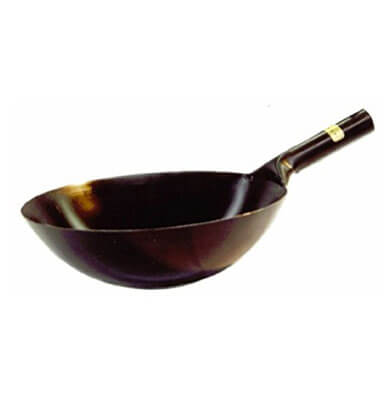
[/one_half]
[one_half_last padding=”0 0 0 2px”]

[/one_half_last]
3. The next best thing
This setup works for serious cooks who want to cook better food but do not have an ideal stove.
Heavy-duty deep skillet + electric stove (or less powerful gas range)
Round bottom cast iron wok + less powerful gas range
Pros:
- The food won’t spill onto the counter
- The pan can reach a really high temperature and hold heat well even on a less powerful stove
- It’s very easy to toss the food, similar to using a round bottom wok
- The pan will last forever if you take good care of it
Cons:
- The cookware is heavy, so it requires a bit of a workout when you clean up the pan
- The pan requires more care (proper seasoning, wash, and dry)
- Depending on how you use the pan, it might generate a lot of smoke during cooking much like a wok
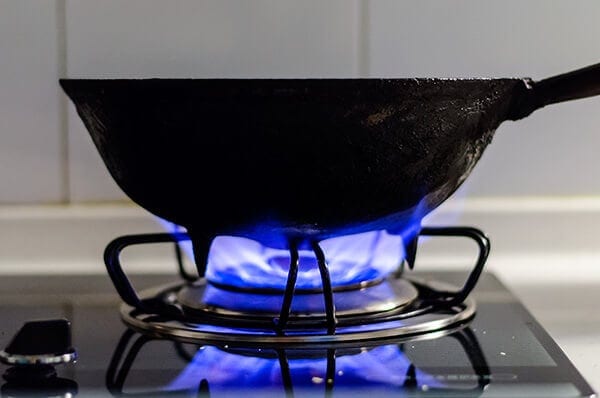
Recommended woks
Debuyer Carbon Steel Deep Skillet (7-lbs) – Shaped almost like a flat-bottom wok, this pan has a large bottom surface that can cover the largest heat element on my electric stove. It heats up fast and holds the heat very well. It has a very high curved edge, so you can cook more food in the pan without spilling any onto your kitchen counter.
Lodge Cast Iron Wok (12-lbs) – This is my absolute favorite when it comes to cooking over a gas stove; its build is way better than some of the cheap options out there. I use this pan with a portable gas stove (12,000 BTU) when I teach a cooking class or to demonstrate authentic stir frying.
I would only recommend this combination to serious cooks who want to cook better food but do not have the luxury to own a powerful indoor gas range or an outdoor cooking space.
[one_half padding=”0 0 0 2px”]
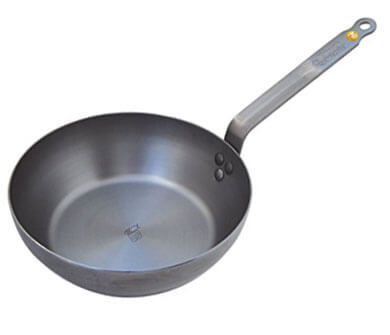
[/one_half]
[one_half_last padding=”0 0 0 2px”]
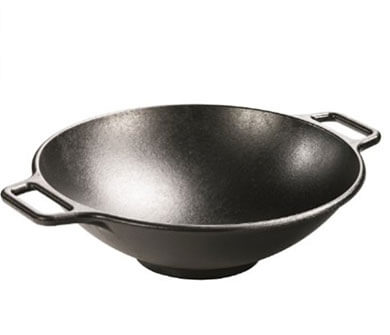
[/one_half_last]
The setup you should always avoid
A wok with small or round bottom surface + electric stove
By having a small bottom surface, the wok bottom cannot fully cover the large heat element of your electric stove. It doesn’t work even you use a heavy pan that holds heat well, like a cast iron wok.
I’ve tried this so many times (with nonstick and cast iron woks) and it never works. It takes forever to heat up the wok with the highest setting. Then your wok will easily overheat and burn the food. Once you add a little sauce or ingredients, it immediately cools down and never really heats up fast enough again to cook the food properly. The result is steamed food that is soggy and watery.
Stir fry spatula – an important element you shouldn’t forget
This is an important element that many books forget to mention, which causes constant frustration. A stir fry spatula is very different from the kind of spatula used in most western kitchens.
- It has longer handle to prevent your hand from being burnt by the hot air
- It has larger spatula surface with sloped edges like a shovel, so you can easily use it to transfer food from the pan onto a plate. Stir frying often involves steps that require you to temporarily remove the food from the pan, so the pan won’t be too crowded and the food won’t overcook. A proper spatula makes this process so much easier
- You can scoop and flip food during cooking to allow the ingredients to be heated evenly
- A stir fry spatula has sharper edges, so it can remove food that has stuck to the pan
If you are using a nonstick pan, you should use a silicon spatula so as not to damage the nonstick coating. If you’re using a cast iron wok or carbon steel pan, a stainless steel spatula works the best.
Watch how I used it making Shrimp Fried Rice.
Conclusion
The best stir fry setup can be very different depending on your goal. None of the setups are perfect, but what you can do is choose one that works for you.
No matter which wok or stir fry pan you choose, as long as you stick to the best practice of stir frying and use solid recipes, you can create better and healthier food in your own kitchen instead of ordering Chinese takeout.
What is your current stir fry setup? Do you have a favorite wok or stir fry pan that you’d like to recommend to others? Leave a comment below to share your thoughts!
Recommended Reading
- How to Make Stir Fry (The Stir Fry Formula) – Introducing the ultimate stir fry formula so you can make any dishes with minimum prep and whatever ingredients you have on hand.
- Stir Fry Recipe Collection on Omnivore’s Cookbook – The stir step towards a successful stir fry is by using solid recipes.
- 20 Basic Chinese Ingredients – Once you gathered these ingredients, you will be able to cook 80% of the Chinese stir fry recipes without the need to run to an Asian grocery store.
- 10 Reasons to Stir Fry with a Frying Pan Instead of a Wok
- How to Season Cast Iron Pans

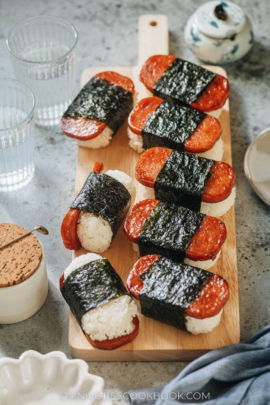
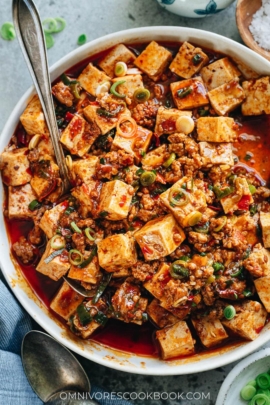

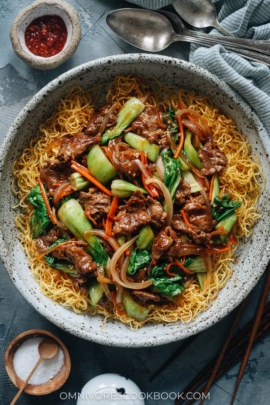
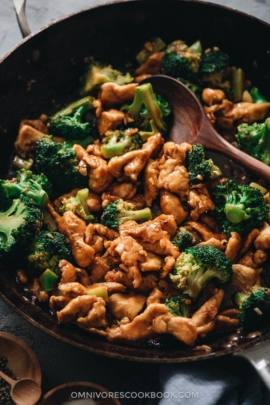
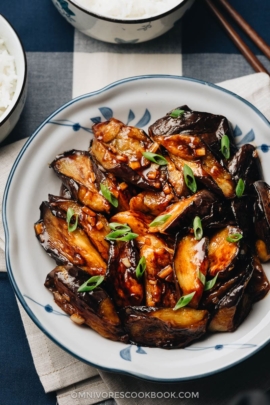






It is time to hit Shanghai street in HK. Did you have a chance to visit cooking street during your last visit? Great post!
No we didn’t have enough time when we visited Hong Kong last time. Plus, it’s probably very difficult to bring things back since I went to a shopping spree every time I visited a cooking market lol
Maggie, thank you so much for the article on pans to use for stir Fry! I am interested in your thoughts using an induction range. Thank you for all your great recipes!
Hi Terry, I’ve never used an induction range. From what I’ve learned from online article, it seems like it works like an electric stove, but heat up much faster. I’d say it works better for stir frying than an electric stove, but you still need to use a flat bottom wok (cast iron or carbon steel should both work well). An induction range seems like a good choice for indoor cooking. If I can choose, my top choice will be a powerful gas range, an induction range comes the next, and lastly electric range.
Hi Maggie, my favorite set-up is a flat bottom cast iron wok on an induction stove top…heats up very quickly, super hot, & shuts down instantly.
This is a great post! I like it that you separated into three different scenarios. I’m guessing the carbon steel needs some care, too, like the cast iron?
I am so afraid to use woks! I have much to learn. For now my husband handles them:) He has gotten pretty good at work. It was amazing to watch street food vendors in Shanghai cooking up anything and everything in a wok with such ease. Simply amazing. Definitely a skill to aspire to!
Great post! I’ve been cooking Chinese for years and never have I found something this comprehensive. With a son who lives in Shanghai and my daughter now temporarily in HK, I know I will be cooking Chinese for many years to come. Loved my visit there but three weeks is not enough!
Hi Abbe, I’m glad to hear you enjoyed Chinese food and would like to cook some in your own kitchen! Indeed three weeks is not enough. I hope you’d like to go back again 🙂
Let me know how the dish turns out if you decided to cook some stir fries in your own kitchen 🙂
This was a great comparison, Maggie! I’ve been asking this question lately too!
Hello and Good-afternoon Maggie! How are you doing today? I have a question . I just purchased a 14′ Imusa Wok from Target. I was reading the reviews and there was more bad than good. However, one review stuck out the most. Because, he said they don’t know how to care for it. I saw a lot saying the coating stripped after one or two use(I assume that wash it with soap after using). Now my question to you is, what is best brand Wokto purchase?
Hi Cai, frankly I don’t really have a brand to recommend because it is more about how you set up your cooking station (e.g. what type of stove you use). My favorite wok back in China is a small cast iron wok with one handle. THe wok is light enough for you to lift with one hand, but heavy enough to gather enough heat on a home gas stove for a proper stir fry (the average gas stove is more powerful in China than the ones in the US). In the US, the major issue is many home cooks do not have a powerful stove to use the thin carbon steel wok. That’s why I recommend Lodge cast iron wok or Debuyer heavy duty carbon steel woks to my readers. The downside is, they are very heavy to handle. If you have a good gas stove, a normal carbon steel wok like Imusa will work just well.
I use wok in my kitchen. To read those post I get more idea to how to use a wok. I like wok to use in my kitchen.
Alternatively, for a true authentic home-style setup if you have an outdoor cooking area, using real lump charcoal (not briquettes) on a charcoal grill with the proper grate, such as: https://www.amazon.com/dp/B0044EQM9Q/ref=asc_df_B0044EQM9Q5271825/?tag=hyprod-20&creative=394997&creativeASIN=B0044EQM9Q&linkCode=df0&hvadid=167141575819&hvpos=1o2&hvnetw=g&hvrand=3742595676332905570&hvpone=&hvptwo=&hvqmt=&hvdev=c&hvdvcmdl=&hvlocint=&hvlocphy=9033781&hvtargid=pla-81416156220 is a good way to mimic a real Chinese commercial kitchen in terms of heat. Although you lack the variability of heat you have with a large gas burner, you can easily modulate the heat of the pan by removing the pan from the grill as needed. One might even argue that this is a more authentic option when looking at true Chinese home setups.
This setup allows you to use a round-bottomed Cantonese or Peking pan, and generates enough heat to give a true wok hei flavor. This is the setup I use, and I have made countless dishes with it. I can attest to the flavor this sort of setup produces. It requires more work and preparation in lighting the coals etc., but is worth it in the long run for those who don’t have access to or don’t want to build a jet burner setup but still want that true Chinese kitchen flavor.
By the way, great website Maggie. I love how you have so many different dishes. For even more recipes, and a more cultural and historic look at wok cooking, I would highly recommend Grace Young’s book “The Breath of a Wok”. It’s available on Amazon, and has beautiful pictures to accompany her exploration of the wok and Chinese wok culture.
Thank you for your recommendation, John! I have Grace Young’s book. It is indeed one of the best stir fry books out there!
Thanks so much for sharing your knowledge, John! I have never tried to cook stir fry on a charcoal grill. I wish I could try it out sometime. Sounds so exciting!
What an informative article! You’ve really covered so many variables for different kinds of cooks and kitchens. I feel like I fall into the 3rd category, I’m really looking to master skills and techniques used in Chinese cooking. I could easily watch YouTube videos all day of Chinese restaurant cooks, I find their speed, comfort level, and skill mesmerizing . But the fact is I will probably never own that type of restaurant set up. I currently live in Malaysia and find that so many of the woks sold here are nonstick or aluminum. So I’m currently just using a wide, flat stainless steel saute pan and am on the lookout for a suitable wok. I’ve seen some at a Korean grocery but they have a different shape.
Really interesting and useful piece. What you say makes so much sense; happy to see your endorsement of the peole paysanne. I love these! So happy to have stumbled across your blog by chance.
Great article Maggie, Thanks for the breakdown. As one who will be soon marrying a wonderful Chinese woman I am in the process of learning and obtaining items to make her more comfortable while in America, (we will be splitting living half in the U.S and half in China). I currently have a Calphalon stainless steel wok I use on a gas stove with a high heat burner. It works great. I made the mistake by buying a bamboo stir fry spatula. After 2 uses it has cracked. So off to get a steel one. Looking at your recipes makes me want to go back soon. Keep up the good work!
I enjoyed this informative analysis of wok vs skillet. My own gas range has a ‘wok burner’ but as supplied the output was only about
4.2KW (14000 BTU). To improve this I reamed out the gas jet to give me a larger flame ( little by little – there are limits to this!) until I had an output of around 5.5 -6 KW (19-20000BTU), a 40% increase. Still way below commercial levels but much, much better. Only problem is my wife refuses to use that ring now – ‘too scary’!
This was such a helpful article, thank you! I currently use a carbon steel wok on a home gas range, but am frustrated with the results. I try to keep my wok seasoned, but no matter what I do, my stir fries always end up with little black spots of burned food. Your article has convinced me to try a non-stick wok, as I do have a wok burner ring on my gas range, which will enable me to heat about 2/3 of the wok directly during cooking. As we mainly cook Cantonese-style dishes with sauces, I’m thinking that cooking at a lower heat with a non-stick wok will improve my results. I think I’ll keep my carbon steel wok, though, for the odd occasions when I want to flash-fry vegetables or similar.
Years ago I took some cooking lessons from a lovely Chinese lady, I learned the basics and she had us cook in Dutch ovens. I adore Asian cooking and living in Nova Scotia the Chinese restaurants cater to the mostly bland diet. I like to cook with my Calalphon steel wok, I think I will look for a cast iron wok. I like to cook a lot and grow many Chinese vegetables. I have a GE Profile gas range, it is pretty powerful and an outside burner which I never thought to cook other than Snow Crab with. What I want to say is that your class is going more in depth and I am enjoying it. Hope you will share your recipe for fried rice. And recommend one of your cook books for experienced cooks who have been cooking Chinese food for a while.
Thank you for your Blog,
Deb
Hi Maggie,
Is there a carbon steel stir fry pan that you would recommend? Thanks, Al
I do! You can find the links in this post: https://omnivorescookbook.com/why-carbon-steel-pan-is-the-best-for-stir-fry/
I really like the Debuyer 12″ fry pan. It’s a good size for stir fry.
Thanks for this. I’ve had a big problem timing the cooking of various elements of my meal. I have a ceramic stove top and a flat bottom stainless steel wok. Somethings work well, but only the bottom 5″ receive heat. I think I will try out my cast iron steel pans over a full burner to see if they make a difference.
Maggie, your section on “Does cooking with a wok make a difference?” answered my question with one of my favorite replies, “Yes and No.” Most things in life, even what fonts and colors to use in a layout, have a pro and a con. You did a great job of explaining the virtues of a wok — and not. You’ve probably guessed I’m a graphic designer, and yes you’re correct. That is the reason I read your entire article. It is so well designed! Big beautiful photos, nice choice of fonts, and stylish colors. Plus, you are an excellent writer. I fake Chinese cooking on my gas grill with a silicone mat, but now that I know the pros and cons of a wok I’ll think I’ll go for the pro and get one. And of course subscribe to your website.
Hi Maggie, Great article! I used to own a pan that I believe was the DeBuyer you recommend. I use a lot of carbon steel, cast iron and enameled cast iron pots, but that particular pan was impossible for me! really large and heavy! I have used 2 different pans successfully lately: my Staub braiser (12″ flat surface, adequate height) and a carbon steel Indian wok. I use the Indian wok for smaller amounts. I have an electric stove, so I can’t get the sides as hot as I would like, but for stir frying small amounts it works nicely.
Love your site, which I just discovered. We cook quite a bit of oriental food and I wanted to comment on woks and stir fry pans. We have an induction cooktop with both stainless steel and cast iron flat bottom woks. With induction, we can get the woks very hot, perhaps not as hot as a commercial gas range but hotter than a typical electric element cooktop and a standard gas range.
It’s good to know that an induction stove top works for you! I’ve used varies stoves in the past but I’ve yet tried induction. I’ve read great things about them and I do love the fact that it heats up faster and you can control the heat better.
Hi Maggie! Have you heard of WokMon? https://www.seriouseats.com/2014/05/the-wok-mon-converts-your-home-burner-into-a-wok-range-solution.html If so, what do you think of it?
It’s my first time hearing about it! Thanks for sharing the link.
I’m afraid I cannot comment on this product because I’ve never tried it before.
I wouldn’t try it with my old gas stove, the cheapest type comes with the apartment, because it can barely boil water. So I don’t think the added 30% output will improve the stove by a lot.
But I think it might be worth looking into if your gas range has a decent output and you want to get your pan a bit hotter.
Hi Maggie – I have owned a WokMan for several years, and find that it works great to really improve the performance of gas stoves. I use it on an Iwatani F35 portable with a carbon steel wok from The Wok Shop, and get great results! I find it much preferable to my Lodge Cast Iron wok on a Vollerath Induction range burner – which can get so hot it trips the safety protection.
“When you’re using a wok on a wrong stove, not only you won’t get wok hei, you cannot even cook food properly. Instead of quickly sear the ingredients, the food will be steamed and become soggy. ” i am so glad you mention this. Yesterday i made my first chicken menu learned from second day. After i turned the meat to fry it on its other side, the hot steam made the meat become soggy. I used deep fry. I understand now that i must excercise this technic of getting the crispyness . Any extra tip to get the meat more crispy ?
your information is really helpful thankyou
I cook on an oil fired Aga. Do you have any recommendations for cooking utensils please?
Thank you, I purchased the Lodge 14″ Wok this morning on your recommendation for my home gas stove of 18500BTU and it arrives tomorrow, thankfully we can also purchase this in the UK.
I actually have a couple DeBuyer carbon steel pans — love them! But for my wok, I splurged and got an even more expensive one than the DeBuyer you suggested: 臻三环 Zhen San Huan Hand Hammered Iron Wok. Any experience with or thoughts on this brand? Or did I just fall victim to their marketing LOL
I haven’t used this wok before but it seems legit. It is similar to the cast iron wok my mom uses in China and I LOVED her wok. The price is properly higher in the US, but in China some very regular stainless pans cost like $200 because it’s imported. If you care the wok properly it will last a life long time so definitely worth the investment 🙂